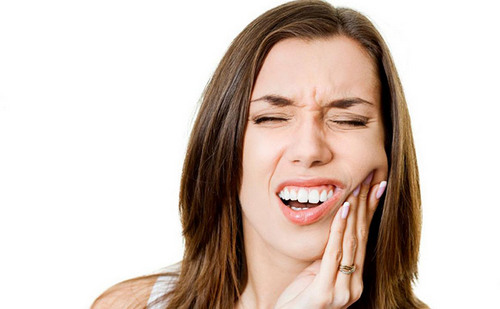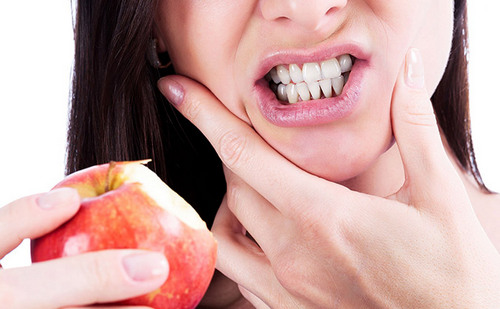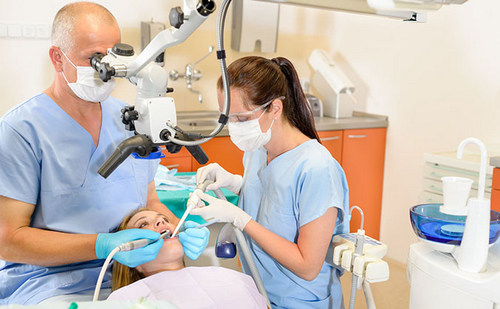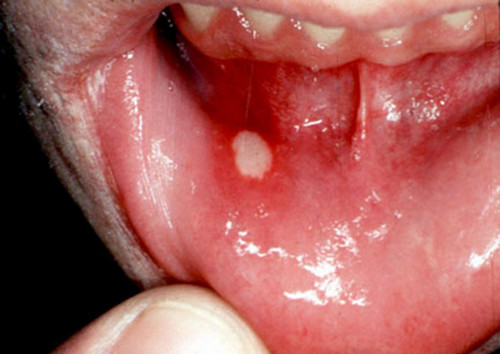Hypersensitivity or tooth sensitivity – one of the most common dental pathologies. Statistics deals with it about 57% of the world population. The complaints of high teeth sensitivity can appear at any age and are a major reason for going to the dentist.
Causes of tooth sensitivity
Hyperesthesia is the result of a thinning or the damage of tooth enamel and a hard tissue, which leads to exposure of the dentinal tubules layer, which directly communicate with the pulp and nerves of the tooth. As a result, the slightest external action on the tooth and it is exposed tubules causes pain and discomfort.
Thinning or the damage of the tooth enamel is influenced by internal and external factors.
The main causes of this disease become the following disorders and diseases.
- An unbalanced diet is depleted in vitamins and minerals.
- Hormonal disorders or uncontrolled intake hormonotherapy drugs.
- Frequent infectious diseases.
- Chronic diseases of the gastrointestinal tract.
- Chronic stress or nervous disorders.
- Malocclusion.
- Abuse of foods with a high acid content.
- Use a toothbrush with hard bristles.
- Independent teeth whitening dubious drugs.
- Pathological increased abrasion of the tooth structure.
- Wedge-shaped defects of teeth.
- Caries, periodontitis, pulpitis or erosion of tooth enamel.
- Bad habits – Smoking, razgryzaniya hard nuts, grinding of teeth etc.
- Previously performed dental procedures – tooth whitening, Tartar removal, fillings, dentures, etc.

In order to efficiently remove the increased sensitivity necessary to accurately determine the cause of disease. Only eliminating it, you can get rid of pain, discomfort and other unpleasant feelings.
Symptoms of sensitivity
The main symptom of hypersensitivity is a transient tooth pain that appears when consuming cold, hot, sour, sweet, spicy food or when brushing your teeth. The pain may be mild and manifest itself in the form of a slight discomfort, or be sharp, very strong and pulsating. In either case, she felt only a few seconds, after which it subsides and completely goes away.
From strong sensitivity of the pain can be local and affect only one or a few teeth, or wear generalized nature to have most of the teeth, or in all that indicates the presence of caries, periodontal disease or neck of tooth exposure.

According to clinical manifestations, to distinguish three degrees of tooth sensitivity.
- I degree – the reaction of teeth to the temperature stimuli.
- Grade II – reaction to thermal and chemical stimuli.
- III degree – a reaction to temperature, chemical and tactile stimuli.
The pain is a constant companion of hyperesthesia and its main symptom. And even if she time passes and the patient can safely consume cold, hot and other irritating food, it does not mean that tooth sensitivity has passed. In this case, it is just a kind of remission that does not cancel a mandatory treatment pathology.
How to treat tooth sensitivity?
Timely treatment helps to get rid of tooth sensitivity and prevent further development of disease that caused its emergence. It can be done at home or at the dentist.
Treatment at home
At home you can use special therapeutic varnishes, gels, powders or foams that help restore the protective properties of enamel.
Depending on the method of issuance, these funds are applied to the surface of the teeth or used to prepare a solution for rinsing.
- Lacquer Bifluorid 12.
- Gel or solution Flocal.
- The Preparation Of The Varnish.
- Powder for preparation of solution Remodent.
- Pasta strontium chloride 75% or 25 % solution for rinsing.
- A 10% solution of calcium gluconate.
- Dental gel Tooth Mousse.
- Dental cream MI Paste Plus.
These products help to reduce tooth sensitivity caused by internal disturbances in the body and minor enamel loss. Use of these drugs is possible only after prior consultation with a dentist.
Toothpastes and mouth rinses

To reduce tooth sensitivity at home with the help of special pastes and mouth rinses.
- Oral-B Sensitive Original.
- Sensodyne-F.
- MEXIDOL dent Sensitive.
- Rembrandt Sensitive.
Toothpaste to reduce tooth sensitivity should be used during the hygienic cleaning of the oral cavity, 2 times a day, morning and evening. To achieve a positive result, it is better to apply the rate – 1 – 2 times a year.
It is important to remember! Medicinal paste as well as varnishes, gels, powders and foams, are effective only in the absence of dental diseases.
Treatment of folk remedies
To reduce the sensitivity of teeth and traditional methods.
Suitable for this purpose the following herbs and remedies.
- The oak bark decoction for rinsing.
- The infusion or decoction of chamomile.
- The warm solution with 3 drops of natural tea tree oil.
- Warm saline solution for rinsing.
- Regular chewing propolis.
- Regular use of warm fresh milk, which is kept in the mouth for 15 – 20 minutes.
Any folk remedy for tooth sensitivity should only be applied with a slight thinning of the enamel. In the presence of severe pathology, you must immediately go to the dentist.
Dental treatment
In most cases, the hyperesthesia caused by dental diseases. Therefore, to get rid of the problem with the help of home methods or advice of traditional medicine does not work. In this case, home events only aggravate the course of disease and leads to the progression of dental diseases.

Do not put off a visit to the dentist even with a slight manifestation of pain to external stimuli. In the Arsenal of modern medicine has effective treatments for all dental ailments. After a thorough diagnosis of the condition of the teeth, an experienced technician can accurately determine the cause of hypersensitivity and conduct the necessary treatment. It may be the elimination of wedge-shaped defects of teeth, treatment of dental caries, periodontitis, pulpitis or erosion of tooth enamel. In the absence of serious diseases, the dentist can undergo the procedure of remineralization of the teeth, which strengthen dental enamel and prevent sensitivity.
Hypersensitivity is not a disease of teeth, but rather a symptom, indicating the presence of dental diseases. And the sooner the contact, the more chances to preserve the health and integrity of teeth.
Tooth sensitivity after whitening
The emergence of hypersensitivity after the whitening procedure is a fairly common complaint of patients. Typically, this involves using aggressive abrasive “miracle remedies” or low-quality products based on hydrogen peroxide. And those and others exude the tooth enamel and cause increased sensitivity to stimuli.
Teeth whitening is a dental procedure. Therefore, its implementation should be handled by professional dentists. They tell in detail how to prepare your teeth for whitening, how to care for your mouth after the procedure and will conduct the necessary whitening using safe products and techniques.
Tooth sensitivity after filling
Hypersensitivity may appear after the seal. This is due to the use during the procedure, 38% phosphoric acid. It is treated with a tooth surface in the overlap area of the seal to achieve a reliable fixation of the filling material. But, unfortunately, this acid makes the tooth enamel is porous, exposing the dentinal tubule layer. Therefore, in order to avoid unpleasant painful sensations after sealing, it is recommended to strictly comply with all recommendations of the attending dentist – they will help to restore the protective function of the enamel.
Tooth sensitivity during pregnancy
The appearance of hyperesthesia during pregnancy – the first sign of thinning tooth enamel, due to the lack of vitamins and essential minerals. In this case, you must reconsider your daily diet in favor of foods high in vitamin D, calcium and magnesium. It is also necessary to limit the use of products containing high amounts of acids. And in order to prevent the development of possible diseases, should consult a dentist or clean the remineralization of teeth.
Tooth sensitivity to cold and hot
Painful symptoms when consuming hot or cold foods – the first sign of hypersensitivity. In this case we are talking about I degree of hypersensitivity that can be caused by thinning tooth enamel or more serious diseases such as tooth decay. So do not put off a visit to the dentist. In the case of minor problems, he will recommend an effective home remedies to reduce the sensitivity. And in the presence of the disease will spend adequate dental treatment.
Prevention and recommendations of dentists
In order to avoid tooth sensitivity and its unpleasant symptoms, should observe the following simple guidelines.
- To balance your diet in favor of foods with a high content of vitamin D, calcium, magnesium and phosphorus.
- To strengthen the immune system of your body.
- To monitor the formation of correct occlusion in children.
- To limit the use of products with a high content of acids.
- Use medicated toothpastes and soft bristle brushes.
- Not to engage an independent teeth whitening.
- Regularly to remove Tartar and hard deposits dentist.
Tooth sensitivity refers to the category of pathologies, which are much easier to prevent than to eliminate. This requires regular, 1 – 2 times annually, checkups at the dentist. The specialist will be able to identify possible tooth problems and conduct timely treatment. Teeth will be healthy and will not cause painful sensations when consuming favorite foods.



